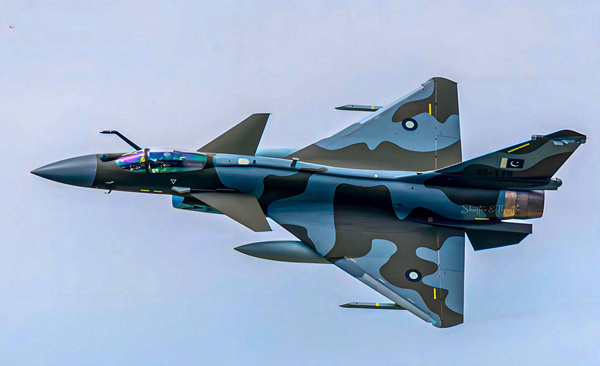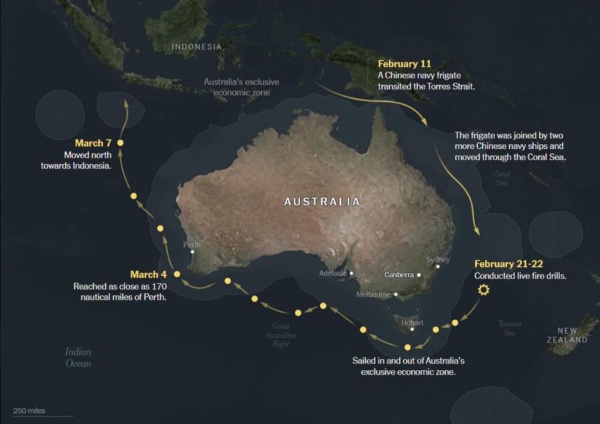编者按:近期,在印度与巴基斯坦空军交火中,巴基斯坦声称其使用中国制造的歼-10战斗机击落了印度的阵风战机,事件引发国际社会广泛关注。
清华大学战略与安全研究中心研究员周波就此在《南华早报》发表评论文章,从国防工业的里程碑、国际军火市场的机遇、解放军战略信心的提升,以及核武库扩充的必要性四个方面分析了这一事件的战略意义。文章指出,这一事件不仅展示了中国武器系统的实战能力,也为中国在全球军事与地缘政治格局中赢得更大影响力提供了契机。
北京对话与观察者网翻译发布中文,以飨读者。
【文/观察者网专栏作者 周波,翻译/ 王凡非】
这是中国的又一个"DeepSeek时刻"。到现在,全世界都已听说巴基斯坦空军如何使用中国制造的歼-10战斗机发射中国制造的PL-15导弹,击落了印度装备的最先进作战飞机--法国制造的阵风战斗机。
中国能从中汲取哪些启示?首先,这是中国国防工业的一个里程碑。这是中国最先进的武器第一次真正有机会证明其可靠性和致命威力。中国已有四十多年未卷入战争。发展是和平的最大红利,中国在自力更生与创新方面的漫长积累终于开花结果。
1991年的海湾战争对中国来说是一记警钟,美国主导的联军对伊拉克的进攻让中国看清了现代战争的作战方式,也让解放军认识到自己的不足。曾经深受苏联体系影响的中国国防工业,如今已能自主研发高科技的尖端武器。
据报道,中国在研发和测试轨道轰炸系统方面处于领先地位,该系统使用低地球轨道上的高超音速滑翔飞行器来打击目标。中国不是拥有一款,而是两款第六代隐形战斗机,这是由两家不同中国公司研发的先进型号。
空战尽管发生在巴基斯坦与印度武装部队之间,但它也是中国与西方武器系统之间首次交锋的开端。
诚然,歼-10战斗机的成功并不意味着它总能胜过法国阵风。两者均为4.5代战机,空战也是雷达系统与导弹制导的较量。但歼-10甚至不是中国空军中最先进的战机--例如,还有第五代战机歼-20,同样由成都飞机公司制造,报道称其年产量高达100架。

巴基斯坦空军歼-10CE战机
其次,经巴基斯坦实战展示后,未来国际军火市场将由美国和中国两大供应商主导。美国在2020至2024年间占据43%的市场份额,未来几十年仍将是最大出口国,部分原因是盟友及某些伙伴会基于政治考量而购买美国武器。
中国在斯德哥尔摩国际和平研究所的排名中位列第四,占全球武器出口的5.9%,落后于美国、法国和俄罗斯,过去主要出口坦克、火炮和小型武器等低端产品。近三分之二的中国武器出口流向巴基斯坦。但此次史无前例的"广告"后,中国各类精良、高性价比的武器将广受欢迎。
中国可能吸引中东和北非的买家,如阿尔及利亚、埃及、伊拉克和苏丹,这些国家通常无法获取最尖端的西方技术。中国还可能在东南亚和拉丁美洲开拓市场。
正如俄乌冲突削弱了对俄制武器的需求--相比战争爆发的2022年,去年俄罗斯的武器出口骤降了47%--印巴冲突也可能会削弱非美制西方武器的吸引力。一位俄罗斯学者曾告诉我,俄罗斯或许有一天会请求中国向其出售武器。对此,我并不感到意外。
第三,中国武器系统在实战中的成功将增强解放军在潜在对抗中的信心和战略地位。近年来,澳大利亚和加拿大等国派出飞机和军舰接近中国沿海,挑战中国的主权主张。即使这些挑衅仅具象征意义,如今也可能会减少。中国海军今年2月在澳大利亚海岸附近进行实弹演习,已向澳大利亚传达了一个信息:解放军也可以以牙还牙。

中国海军军舰航迹图,资料来源:澳大利亚国防部
解放军在台湾海峡和南海的演习将更加频繁,科目演练更趋复杂。这将迫使美国在任何军事干预前三思而行。
正如最新的关税对抗所显示的那样,中国是唯一有胆识和实力对抗美国的国家。美国在台湾防卫问题上采取的"战略模糊"政策,如今看起来更像是为美军无法在中国本土赢得胜利所遮掩的一块遮羞布。
第四,尽管中国在常规武器方面进展迅速,但仍应增加其核武库。鉴于印巴冲突是一场常规战争,这一结论或许出人意料。然而,正因为两国在核弹头数量上势均力敌--印度被认为拥有172枚,巴基斯坦拥有170枚--才促成了他们之间迅速达成(尽管脆弱的)停火。这种力量对比使双方都无法承受冲突升级为核战争的代价。
五角大楼估计中国有600枚核弹头。美国的核弹头数量据信接近中国的十倍。如果中国仅维持这一数量,难道不会让美国在台海危机中胆大妄为到首先动用核武器吗?毕竟,一些美国智库已经提出过这种可能性。
中国从俄乌冲突中汲取的一个教训是,俄罗斯的核武库有效阻止了北约直接介入冲突。对中国而言,技术能力和资金投入都不是主要问题,关键在于是否作出政治决策。拥有更多核武器并不会削弱中国"不首先使用"核政策,但在冲突不可避免时,这将为中国在家门口争取胜利提供更有力的保障。
(翻页查看英文原文)
This is another "DeepSeek moment" for China. By now, the world will have heard of how the Pakistan Air Force used Chinese-made J-10 fighter jets with Chinese-made PL-15 missiles to shoot down India's French-made Rafale fighter jets, its best enlisted combat aircraft.
What lessons might Beijing draw? First, this is a milestone for China's defence industry. Until now, China's state-of-the-art weapons have had no real chance of proving their reliability or lethal power. China has not been at war in more than four decades. Development has been the largest dividend of peace and China's long march of self-reliance and innovation is producing results.
The 1991 Gulf War was a wake-up call for China to modernise the People's Liberation Army (PLA). The US-led coalition's attack on Iraq showed China what a modern war looked like - and how inadequately prepared the PLA was. Chinese defence, heavily influenced in its early years by Russian systems, has now become a hi-tech modern force developing sophisticated weapons of its own.
China reportedly leads in developing and testing a fractional orbital bombardment system that uses a hypersonic glide vehicle on a low-Earth orbit to reach its target. It also reportedly has not one but two sixth-generation stealth fighters, advanced models that two different Chinese companies have come up with.
The aerial fight may have been between the armed forces of Pakistan and India, but it was also the first round of a duel between Chinese and Western weapon systems.
True, the reported success of the J-10 fighter jet does not necessarily mean it will always prevail over the French Rafale. Both are 4.5-generation aircraft and an aerial fight is also a contest between radar systems and missile guidance. But the J-10 is not even the best aircraft in China's air force - for one, there is also the 5th-generation J-20, also manufactured by the Chengdu Aircraft Company, which is reportedly pushing them out at a rate of 100 a year.
Secondly, after the display in Pakistan, the international arms market will come to be dominated by just two suppliers: the US - and China. The United States, which commanded 43 per cent of the market from 2020-2024, will remain the biggest exporter for decades, in part because allies and some partners buy American arms for political reasons.
China, which came fourth on the Stockholm International Peace Research Institute list with 5.9 per cent of global arms exports - after the US, France and Russia - used to sell low-end products such as tanks, artillery and small arms. Nearly two-thirds of China's arms exports go to Pakistan. But after this unprecedented advertisement, Chinese arms of all types, with their sophistication and affordability, will become more popular.
China could be approached by buyers in the Middle East and North Africa such as Algeria, Egypt, Iraq and Sudan, states that typically cannot access the most cutting-edge Western technology. It may also find markets in Southeast Asia and Latin America.
Just as the Ukraine war hurt demand for Russian weapons - exports plummeted by 47 per cent last year compared to 2022 when the war began - so the India-Pakistan conflict is likely to reduce the appeal of non-US weapons from the West. One Russian scholar told me Moscow may well ask Beijing to sell it arms one day; I was not really surprised.
Thirdly, the combat success of Chinese weapons systems will enhance the PLA's confidence and strategic position in a potential showdown. In recent years, countries such as Australia and Canada have sent aircraft and ships near the Chinese coast to challenge China's claims. Such provocations, even if merely symbolic, may now decrease. The Chinese navy's live firing exercise off Australia's coast in February told Canberra the PLA could do the same in return.
PLA exercises in the Taiwan Strait and South China Sea will become more often and more sophisticated in rehearsing scenarios. It will make the US think twice about any military intervention.
As the latest tariff showdown demonstrates, China is the only county with the guts and heft to push back against the US.
Washington's policy of "strategic ambiguity" over the defence of Taiwan now seems more like a fig leaf fo a US military unable to guarantee a win on Chinese home turf.
Fourthly, China should increase its nuclear stockpile even if it is making swift advances in conventional weapons. This might be an unexpected conclusion given the India-Pakistan conflict is a conventional one. But their swift truce - if fragile - is also precisely because the two nuclear powers are evenly matched in terms of warheads: India is thought to have 172 to Pakistan's 170, and neither can afford for their conflict to escalate into a nuclear war.
Should China maintain its nuclear arsenal of 600 warheads, as estimated by the Pentagon, might it not embolden the US, which is thought to have nearly 10 times as many warheads, to think about using nuclear bombs first in a Taiwan Strait crisis, as some American think tanks have suggested?
One lesson China has learned from the Ukraine war is that Russia's nuclear stockpile deters Nato from directly involving the transatlantic security alliance in the conflict. For Beijing, neither technical know-how nor financial investment is a big problem. It is more a question of making a political decision. Having more nuclear weapons won't compromise China's no-first-use policy - but it would give China a better chance of a win at its doorstep should a conflict become inevitable.

本文系观察者网独家稿件,文章内容纯属作者个人观点,不代表平台观点,未经授权,不得转载,否则将追究法律责任。关注观察者网微信guanchacn,每日阅读趣味文章。